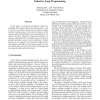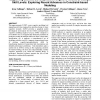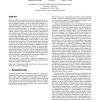1380 search results - page 126 / 276 » Learning Hierarchical Shape Models from Examples |
ICTAI
2007
IEEE
14 years 4 months ago
2007
IEEE
In this paper we developed an Inductive Logic Programming (ILP) based framework ExOpaque that is able to extract a set of Horn clauses from an arbitrary opaque machine learning mo...
NIPS
2004
13 years 11 months ago
2004
First-order Markov models have been successfully applied to many problems, for example in modeling sequential data using Markov chains, and modeling control problems using the Mar...
CHI
2005
ACM
14 years 10 months ago
2005
ACM
This paper presents X-PRT, a new cognitive modeling tool supporting activities ranging from interface design to basic cognitive research. X-PRT provides a graphical model developm...
BMCBI
2011
13 years 1 months ago
2011
Background: The search for cluster structure in microarray datasets is a base problem for the so-called “-omic sciences”. A difficult problem in clustering is how to handle da...
VISUALIZATION
1997
IEEE
14 years 2 months ago
1997
IEEE
Recursive subdivision schemes have been extensively used in computer graphics and scientific visualization for modeling smooth surfaces of arbitrary topology. Recursive subdivisi...



